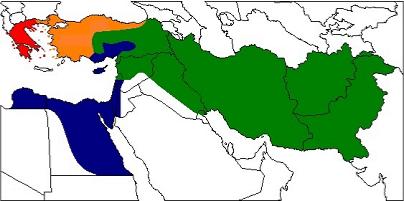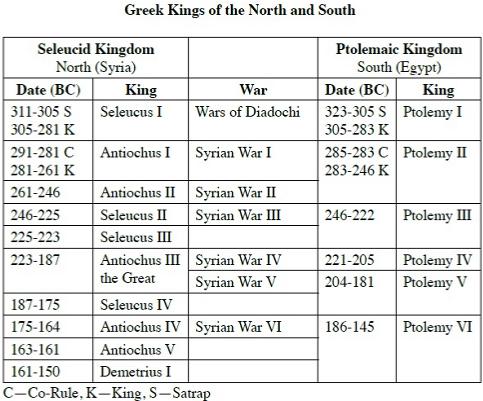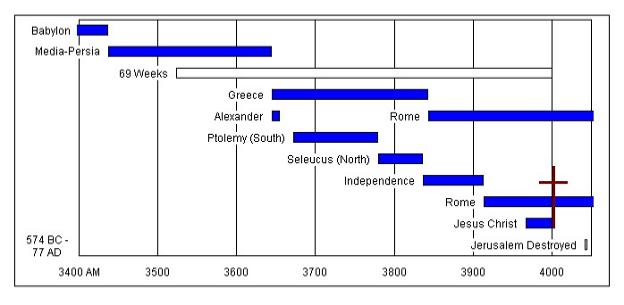
Daniel 10-12: Daniel's Final Vision - Part 3: Antiochus IV
October 2023
October 2023
In 539 BC, Cyrus the Great conquered Babylon and rules Media-Persia. Daniel prays three weeks and is given the final vision of Media-Persia, Greece and the Tribulation. Daniel 11 is the greatest chapter of fulfilled prophecy with ~135 fulfilled prophecies in 35 verses. It covers 374 years (538 to 164 BC) with Media-Persia, Greek wars of succession and wars between Greek Syria (north) and Greek Egypt (south) for control of Syria, Lebanon and Judea. Daniel 11:21-35 describes the prophecy of Antiochus IV of Greek Syria (north), a type of the future Antichrist.
Syrian War V
Then shall stand up in his estate a raiser of taxes in the glory of the kingdom: but within few days he shall be destroyed, neither in anger, nor in battle (Daniel 11:21).
Previously, Alexander the Great conquers Media-Persia but his kingdom is divided between four generals. Later, Antiochus III, the Great of Greek Syria (north), takes Judea from Ptolemy V of Greek Egypt (south). Then he invades the coast of Asia Minor but Roman general Scipio Asiaticus defeats him and forces him to pay tribute. After Antiochus dies, Seleucus IV (north) sent tax collector Heliodorus to seize the gold in the Jewish temple. But Heliodorus assassinates Seleucus tries to usurp the throne but dies. Rightful heir Demetrius I, son of Seleucus, is a prisoner in Rome for tribute owed. His infant brother Antiochus becomes king. See Daniel 11.
Antiochus IV Epiphanes
In his estate shall stand up a vile person, to whom they shall not give the honour of the kingdom: but he shall come in peaceably, and obtain the kingdom by flatteries (Daniel 11:21).
Syrian War V
Then shall stand up in his estate a raiser of taxes in the glory of the kingdom: but within few days he shall be destroyed, neither in anger, nor in battle (Daniel 11:21).
Previously, Alexander the Great conquers Media-Persia but his kingdom is divided between four generals. Later, Antiochus III, the Great of Greek Syria (north), takes Judea from Ptolemy V of Greek Egypt (south). Then he invades the coast of Asia Minor but Roman general Scipio Asiaticus defeats him and forces him to pay tribute. After Antiochus dies, Seleucus IV (north) sent tax collector Heliodorus to seize the gold in the Jewish temple. But Heliodorus assassinates Seleucus tries to usurp the throne but dies. Rightful heir Demetrius I, son of Seleucus, is a prisoner in Rome for tribute owed. His infant brother Antiochus becomes king. See Daniel 11.
Antiochus IV Epiphanes
In his estate shall stand up a vile person, to whom they shall not give the honour of the kingdom: but he shall come in peaceably, and obtain the kingdom by flatteries (Daniel 11:21).
Uncle Mithradates, son of Antiochus the Great and brother of Seleucus IV, led a coup to become regent for nephew Antiochus. He has Antiochus killed and changes his name to the infamous Antiochus IV Epiphanes. The name Epiphanes means shining one but opponents called him Epimanes or madman. He gained power by using diplomacy with the king of Pergamus in Asia Minor and paying overdue tribute to Rome.
Divided Greek Empire 301 BC Wars of Diadochi (Succession)
Syrian War VI
And with the arms of a flood shall they be overflown from before him, and shall be broken; yea, also the prince of the covenant. And after the league made with him he shall work deceitfully: for he shall come up, and shall become strong with a small people. He shall enter peaceably even upon the fattest places of the province; and he shall do that which his fathers have not done, nor his fathers' fathers; he shall scatter among them the prey, and spoil and riches (Daniel 11:22-23, 24).
In 170 BC, Antiochus fights Ptolemy VI of Greek Egypt. He replaces Jewish High Priest Onias III. Then he attempts to abolish Judaism and force the Jews to Hellenize by following Greek culture. Alexandria, Egypt rejects Ptolemy VI as king in favor of sister/wife Cleopatra II and brother Ptolemy VII so he and uncle Antiochus scheme together and make a treaty. At home, Antiochus shares the spoils of war to bribe his generals and the people.
And he shall stir up his power and his courage against the king of the south with a great army; and the king of the south shall be stirred up to battle with a very great and mighty army. Yea, they that feed of the portion of his meat shall destroy him, and his army shall overflow: and many shall fall down slain. And both of these kings' hearts shall be to do mischief, and they shall speak lies at one table; but it shall not prosper: for the end shall be at the time appointed. Then shall he return into his land with great riches; and his heart shall be against the holy covenant; and he shall do exploits, and return to his own land (Daniel 11:25-26, 27-28).
In 168, Antiochus fights Ptolemy of Egypt. Ptolemy's sister/wife and brother co-rule but oust him. Then Antiochus conquers most of Egypt and captures Ptolemy. This develops into a deceitful alliance to take Alexandria but fails. The Jews heard a rumor that Antiochus was killed in battle and former High Priest Jason takes control of Jerusalem. Returning to Syria, Antiochus attacked Jerusalem, plundered the temple and massacred 40,000 people.
And with the arms of a flood shall they be overflown from before him, and shall be broken; yea, also the prince of the covenant. And after the league made with him he shall work deceitfully: for he shall come up, and shall become strong with a small people. He shall enter peaceably even upon the fattest places of the province; and he shall do that which his fathers have not done, nor his fathers' fathers; he shall scatter among them the prey, and spoil and riches (Daniel 11:22-23, 24).
In 170 BC, Antiochus fights Ptolemy VI of Greek Egypt. He replaces Jewish High Priest Onias III. Then he attempts to abolish Judaism and force the Jews to Hellenize by following Greek culture. Alexandria, Egypt rejects Ptolemy VI as king in favor of sister/wife Cleopatra II and brother Ptolemy VII so he and uncle Antiochus scheme together and make a treaty. At home, Antiochus shares the spoils of war to bribe his generals and the people.
And he shall stir up his power and his courage against the king of the south with a great army; and the king of the south shall be stirred up to battle with a very great and mighty army. Yea, they that feed of the portion of his meat shall destroy him, and his army shall overflow: and many shall fall down slain. And both of these kings' hearts shall be to do mischief, and they shall speak lies at one table; but it shall not prosper: for the end shall be at the time appointed. Then shall he return into his land with great riches; and his heart shall be against the holy covenant; and he shall do exploits, and return to his own land (Daniel 11:25-26, 27-28).
In 168, Antiochus fights Ptolemy of Egypt. Ptolemy's sister/wife and brother co-rule but oust him. Then Antiochus conquers most of Egypt and captures Ptolemy. This develops into a deceitful alliance to take Alexandria but fails. The Jews heard a rumor that Antiochus was killed in battle and former High Priest Jason takes control of Jerusalem. Returning to Syria, Antiochus attacked Jerusalem, plundered the temple and massacred 40,000 people.
At the time appointed he shall return, and come toward the south; but it shall not be as the former, or as the latter. For the ships of [Cypress] shall come against him: therefore he shall be grieved, and return, and have indignation against the holy covenant: so shall he do; he shall even return, and have [favor] with them that forsake the holy covenant (Daniel 11:29-30).
In 168 BC Antiochus fights Egypt again but circumstances have drastically changed. Ptolemy reconciled with his sister/wife and brother and Egypt became a protectorate of Rome. When Antiochus goes to Egypt, the Roman Commander Popillius Laenas drew a circle in the sand and forced him to surrender. Humiliated and angry, he attacked Judea and devout Jews. Because of the Hellenistic culture and persecution, many Jews rejected God and worshiped Greek gods. Antiochus attempted to convert remaining Jews by force.
Jewish Temple Desecrated
And arms shall stand on his part, and they shall pollute the sanctuary of strength, and shall take away the daily sacrifice, and they shall place the abomination that makes desolate. And such as do wickedly against the covenant shall he corrupt by flatteries: but the people that do know their God shall be strong, and do exploits (Daniel 11:31-32).
Antiochus' forces destroy much of Jerusalem. On the 15th of Kislev (December), 168 BC, the army set up an image of the Greek pagan god Zeus in the Jewish temple and sacrificed pigs to Zeus. Hellenized Jews ate the pigs but those that refused are killed. Jewish priest Mattathias refused to sacrifice pigs and he threatened to kill priests that do. This began the Jewish struggle for independence from Greek Syria.
In 168 BC Antiochus fights Egypt again but circumstances have drastically changed. Ptolemy reconciled with his sister/wife and brother and Egypt became a protectorate of Rome. When Antiochus goes to Egypt, the Roman Commander Popillius Laenas drew a circle in the sand and forced him to surrender. Humiliated and angry, he attacked Judea and devout Jews. Because of the Hellenistic culture and persecution, many Jews rejected God and worshiped Greek gods. Antiochus attempted to convert remaining Jews by force.
Jewish Temple Desecrated
And arms shall stand on his part, and they shall pollute the sanctuary of strength, and shall take away the daily sacrifice, and they shall place the abomination that makes desolate. And such as do wickedly against the covenant shall he corrupt by flatteries: but the people that do know their God shall be strong, and do exploits (Daniel 11:31-32).
Antiochus' forces destroy much of Jerusalem. On the 15th of Kislev (December), 168 BC, the army set up an image of the Greek pagan god Zeus in the Jewish temple and sacrificed pigs to Zeus. Hellenized Jews ate the pigs but those that refused are killed. Jewish priest Mattathias refused to sacrifice pigs and he threatened to kill priests that do. This began the Jewish struggle for independence from Greek Syria.
Babylon 586 BC, Media-Persia 539 BC, Greece 331 BC, Independence 140 BC, Rome 63 BC
Hanukkah and Independence
And they that understand among the people shall instruct many: yet they shall fall by the sword, and by flame, by captivity, and by spoil, many days. Now when they shall fall, they shall be helped with a little help: but many shall cleave to them with flatteries. And some of them of understanding shall fall, to try them, and to purge, and to make them white, even to the time of the end: because it is yet for a time appointed (Daniel 11:33-34, 35).
Despite severe persecution, Mattathias and his son, Judas Maccabeus, revolted against Greek Syria. The bravery of devout Jews encouraged others to follow. The defiled temple lasted for 1150 days. From the 15th of Kislev 168 BC to the 25th of Kislev 165 BC is three years of 360 days, two leap months and ten days (1080+60+10). The Jewish temple is rededicated on the first day of Hanukkah.
Antiochus left to confront the Parthians in Persia (Iran). His general, Lysias, fought Judea. By 165 BC, Judea recaptured the Jewish temple and rededicated the altar. In 164 BC, Antiochus dies from disease in Persia. Later in 141 BC, the Jewish people began seventy-eight years of independence during the reign of priests in the Hasmonean Kingdom. In 63 BC during the Pharisees and Sadducees religious civil war, Rome intervened and captured Judea. With the loss of independence and Roman persecution, Jews sought a political messiah like Judas Maccabeus during Jesus Christ's ministry. In 70 AD, the Jews expected God to deliver them like the Greeks but Rome crushed the rebellion and the Jews scatter.
Daniel 11:36-45 is prophecy that is still future. A prophecy gap of about 2200 years exists. Antiochus IV is a type of future Antichrist that will rule the world during the Great Tribulation. Both leaders persecute the Jewish people for three years but are eventually destroyed by the hand of God.
And they that understand among the people shall instruct many: yet they shall fall by the sword, and by flame, by captivity, and by spoil, many days. Now when they shall fall, they shall be helped with a little help: but many shall cleave to them with flatteries. And some of them of understanding shall fall, to try them, and to purge, and to make them white, even to the time of the end: because it is yet for a time appointed (Daniel 11:33-34, 35).
Despite severe persecution, Mattathias and his son, Judas Maccabeus, revolted against Greek Syria. The bravery of devout Jews encouraged others to follow. The defiled temple lasted for 1150 days. From the 15th of Kislev 168 BC to the 25th of Kislev 165 BC is three years of 360 days, two leap months and ten days (1080+60+10). The Jewish temple is rededicated on the first day of Hanukkah.
Antiochus left to confront the Parthians in Persia (Iran). His general, Lysias, fought Judea. By 165 BC, Judea recaptured the Jewish temple and rededicated the altar. In 164 BC, Antiochus dies from disease in Persia. Later in 141 BC, the Jewish people began seventy-eight years of independence during the reign of priests in the Hasmonean Kingdom. In 63 BC during the Pharisees and Sadducees religious civil war, Rome intervened and captured Judea. With the loss of independence and Roman persecution, Jews sought a political messiah like Judas Maccabeus during Jesus Christ's ministry. In 70 AD, the Jews expected God to deliver them like the Greeks but Rome crushed the rebellion and the Jews scatter.
Daniel 11:36-45 is prophecy that is still future. A prophecy gap of about 2200 years exists. Antiochus IV is a type of future Antichrist that will rule the world during the Great Tribulation. Both leaders persecute the Jewish people for three years but are eventually destroyed by the hand of God.
References: 21st Century Revelation: World Wars, Iraq Wars & End War Chapter 8 - Prophecy Fulfilled, Appendix C - Prophecy Fulfilled, Daniel 2: The Statue & the Rock, Daniel 8: The Ram & Goat, Wars of Diadochi (Succession), Greek Syrian Wars, Revelation Outline, Covenant, Tribulation, Revelation, 21st Century View, Daniel, America, Timeline of the Tribulation

21st Century Revelation: World Wars, Iraq Wars & End Wars
A current understanding of God's plan for our time
Copyright © 21st Century Revelation Ministry 2025
A current understanding of God's plan for our time
Copyright © 21st Century Revelation Ministry 2025

Greece Divided
• Greece - Lysimachus
• Asia Minor - Cassander
• Syria/Babylon/Persia - Seleucus (North)
• Egypt - Ptolemy (South)
• Greece - Lysimachus
• Asia Minor - Cassander
• Syria/Babylon/Persia - Seleucus (North)
• Egypt - Ptolemy (South)
Gentile Rule

| Home | Articles | First Coming | Jewish Calendar | Preview | Purchase | Reviews | Schedule | About |








